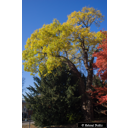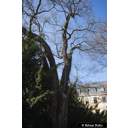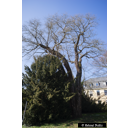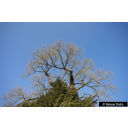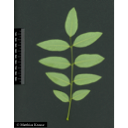Useful information about the taxon (species, subspecies, variety...)
Styphnolobium japonicum (L.) Schott
Fabaceae (Leguminosae, Papilionaceae)
(APG IV)Akzessionnummer: EG-I-067-25089
Pflanzjahr: 2020
Patenschaftstext: Hanibal Jagvaral in memoria aeterna
Taxon concept: The Plant List (2014), version 1.1
Styphnolobium japonicum (L.) Schott - Accepted: Styphnolobium japonicum (L.) Schott bei The Plant List (2010); Familie: Fabaceae (Leguminosae, Papilionaceae) (APG III)Styphnolobium japonicum (L.) Schott - Accepted: Styphnolobium japonicum (L.) Schott bei Zander 2008; Familie: Fabaceae (Leguminosae, Papilionaceae) (Zander 2008)Sophora japonica L. - Synonym: Styphnolobium japonicum (L.) Schott bei Zander 2008; Familie: Fabaceae (Leguminosae, Papilionaceae) (Zander 2008)Styphnolobium japonicum (L.) Schott - Accepted: Styphnolobium japonicum (L.) Schott bei The Plant List (2014), version 1.1; Familie: Fabaceae (Leguminosae, Papilionaceae) (APG III)Styphnolobium japonicum (L.) Schott - Accepted: Styphnolobium japonicum (L.) Schott bei The Plant List (2010); Familie: Fabaceae (Leguminosae, Papilionaceae) (APG IV)Sophora japonica L. - Accepted: Sophora japonica L. bei BfN Checklist Flora DE; Familie: Fabaceae (Leguminosae, Papilionaceae) (APG IV)Styphnolobium japonicum (L.) Schott - Accepted: Styphnolobium japonicum (L.) Schott bei World Flora Online - APG IV (Angiosperms); Familie: Fabaceae (Leguminosae) (World Flora Online - APG IV (Angiosperms))
- Color of flower
- white
- Life form
- woody, tree
Bundesamt für Naturschutz (BfN) (1999-2001 and ongoing): Floraweb - Daten und Informationen zu Wildpflanzen und zur Vegetation Deutschlands. www.floraweb.de.; Haider, M. et al. (2005): Wildbienenkataster. See: https://www.wildbienen-kataster.de; Jäger, E. (Hrsg.) (2011): Rothmaler - Exkursionsflora von Deutschland. Gefäßpflanzen: Grundband. Band 2. Springer Spektrum Verlag, 20., neu bearb. u. wesentl. erw. Aufl.: 944 S. 978-3-8274-1606-3.; Jäger, E. J. et al. (2007): Rothmaler - Exkursionsflora von Deutschland. Band 5: Krautige Zier- und Nutzpflanzen. Spektrum Akademischer Verlag, Aufl. 31.10.2007: 880.; Maurizio, Anna et al. (1982): Nektar und Pollen - die wichtigsten Nahrungsquellen der Honigbiene. 4. Ehrenwirth, München, 3, überabeitete Auflage; Ministerium für Ernährung, Landwirtschaft, Umwelt und Forsten, Baden-Württemberg (Hrsg.) (1985): Pflanzenkatalog zur Verbesserung der Bienenweide und des Artenreichtums (Kurztitel: Bienenweidekatalog); Oberdorfer, E. (2001): Pflanzensoziologische Exkursionsflora. Für Deutschland und angrenzende Gebiete. Eugen Ulmer Verlag, Stuttgart, 8., stark überarb. u. erg. Aufl, 1056 S. 978-3-8001-3131-0.; Pritsch, Günter et al. (1985): Bienenweide.. Neumann-Neudamm, Melsungen; Pritsch, Günter et al. (2007): 200 Trachtpflanzen erkennen und bewerten.. Kosmos, Stuttgart; Schick, B. & Spürgin, A. (1997): Die Bienenweide. Eugen Ulmer Verlag, Stuttgart, Auflage: 4., völlig neubearb. u. erw. A., 216 S. 978-3800174188.; The International Plant Names Index (2009). Published on the Internet http://www.ipni.org; Courtesy to IPNI, 2009. Exported from IPNI at date: 2009-09-22 20:17:51; Westrich, P. et al. (2018): Die Wildbienen Deutschlands.. Ulmer Verlag ISBN 978-8186-0123-2.;
Diese Webseite verwendet Google Maps, um Karten und Standorte von Pflanzen in den Hohenheimer Gärten anzuzeigen. Dadurch werden unter Umständen Daten an Google weitergeleitet, was mit einer Verarbeitung Ihrer personenbezogenen Daten verbunden sein kann. Die Datenschutzerklärung von Google finden Sie hier: Datenschutzerklärung von Google

